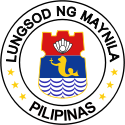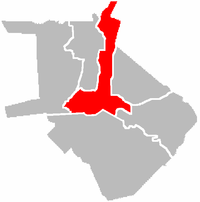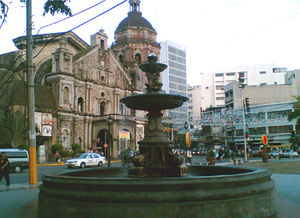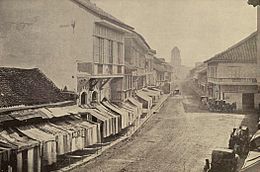- Binondo, Manila
-
Binondo Nickname(s): Chinatown Location of Binondo in Manila's 3rd legislative district Country Philippines Region National Capital Region City Manila Congressional districts Part of the 3rd district of Manila Barangays 10 Area – Total 0.66 km2 (0.26 sq mi) Population (2007[1]) – Total 12,100 – Density 18,333.3/km2 (47,483.1/sq mi) Binondo is an enclave in Manila primarily populated by ethnic Chinese living in the Philippines. Chinatown, Manila (Binondo) is the oldest Chinatown in the world, established in 1594.[2] Historically, this was where the Spanish permitted converted sangleys, their indigenous Filipino wives, and their mixed-race descendants, the mestizos de sangley or Chinese mestizos, to reside. Similarly, Parían, an area near Intramuros, was where the Spanish first restricted unconverted Chinese immigrants. They allowed sangley settlement at Parían because it was within the range of Intramuros' cannons, and they felt they could control any uprising from the labourers.
Located across the Pasig River from Intramuros, Binondo has typified a small Chinese town, and is referred to as the local "China Town". The district is the centre of commerce and trade for all types of businesses run by Filipino-Chinese merchants. Given the historic reach of Chinese trading in the Pacific, Binondo was already a hub of Chinese commerce before the first Spanish colonisers arrived in 1521.
Binondo is also considered a historic centre of the mestizo de sangley community; famous residents include St. Lorenzo Ruiz, the Filipino protomartyr, and Venerable Mother Ignacia del Espiritu Santo, founder of the Congregation of the Religious of the Virgin Mary.
Contents
Etymology
The name "Binondo" is a toponym derived from the archaic spelling of the Tagalog term "binondoc" (modern orthography: binundók), or mountainous, referring to the district's originally hilly terrain.
History
Founded in 1594, Binondo was created by Spanish Governor Luis Pérez Dasmariñas as a permanent settlement for Chinese immigrants (the Spanish called the Chinese sangleys) who converted to Catholicism. It was across the river from the walled city of Intramuros, where the Spaniards resided. Originally it was intended to replace the Parian near Intramuros, where the Chinese were first confined. The Spanish gave a land grant for Binondo to a group of Chinese merchants and artisans in perpetuity, tax-free and with limited self-governing privileges.
The Spanish Dominican fathers made Binondo their parish and succeeded in converting many of the residents to Catholicism. Binondo soon became the place where Chinese immigrants converted to Catholicism, intermarried with indigenous Filipino women and had children, who became the Chinese mestizo community. Over the years, the Chinese mestizo population of Binondo grew rapidly. This was caused mainly because the lack of Chinese immigrant females and the Spanish officials' policy of expelling or killing (in conflicts) Chinese immigrants who refused to convert.
In 1603 a Chinese revolt took place led by Juan Suntay, a wealthy Catholic Chinese. It was put down by joint Spanish and native forces led by Luis Pérez Dasmariñas. In the aftermath most of the 20,000 Chinese that composed the colony were killed. The revolt took place right after a visit to Manila by three official Chinese representatives who disclosed they were searching for "a mountain of gold". This strange claim prompted the Spanish to conclude that there was an imminent invasion from China in the making. At the time the local Chinese outnumbered the Spaniards by twenty to one, and Spanish authorities feared that they would join the invading forces.[3] The Chinese afterward played down those events in an attempt to preserve their commercial interests, and in 1605 a Fukien official issued a letter claiming that the Chinese who had participated in the revolt were unworthy of China's protection, describing them as "deserters of the tombs of their ancestors".[4]
During the brief British occupation of Manila, between 1762 and 1764, Binondo was bombarded on several occasions and some of its structures destroyed. Many Spanish, Mestizos, Chinese and natives were killed and brought into prisons indiscriminately. [5]
Binondo became the main center for business and finance in Manila for the ethnic Chinese, Chinese mestizos and Spanish Filipinos. During the Spanish colonial period, many esteros (canals) were constructed in the Binondo area, from where they entered the Pasig River. Among the many who married at the historic Binondo Church was Andres Bonifacio in 1895, who became a hero of the Philippine Revolution.
Before World War II, Binondo was the centre of a banking and financial community which included insurance companies, commercial banks and other financial institutions from Britain and the United States. These banks were located mostly along Escólta, which used to be called the "Wall Street of the Philippines".
After the war and new development, most businesses began to relocate to the newer area of Makati. During the financial crisis of the early 1980s, it had the moniker "Binondo Central Bank", as the local Chinese businessmen engaged in massive black market trading of US Dollars, which often determined the national Peso-Dollar exchange rate. Given its rich historical and financial significance, Binondo is said to have one of the highest land values nationwide.
Barangays
The largest barangay in Binondo is San Nicolás.
Zone 27: 287, 288, 289, 290, 291 Zone 28: 292, 293, 294, 295, 296 Zone 25: 276[citation needed]Barangays of Binondo Name Population (2007 census)[1] Barangay 287 2,445 Barangay 288 1,772 Barangay 289 543 Barangay 290 388 Barangay 291 370 Barangay 292 2,600 Barangay 293 571 Barangay 294 1,416 Barangay 295 1,145 Barangay 296 850 Places of interest
- Plaza San Lorenzo Ruiz
- Binondo Church
- Chinatown
In Literature
Binondo was mentioned several times in the novels of Dr. Jose Rizal, for example, in Noli Me Tangere and El Filibusterismo.
See also
References
- ^ a b Final Results - 2007 Census of Population
- ^ Raitisoja, Geni " Chinatown Manila: Oldest in the world", Tradio86.com, July 8, 2006, accessed March 19, 2011.
- ^ Chi Tien, Liu (1955). Hua-ch’iao tui-yu Fei-lu-pin (The Overseas Chinese in the Philippines). Manila. pp. 37–41.
- ^ MacNair, H.F. (1923). The Relation of China to her Nationals Abroad. pp. 30.
- ^ Backhouse, Thomas (1765). The Secretary at War to Mr. Secretary Conway. London: British Library. pp. v. 40.
City of Manila 
Legistlative districts of Manila Districts of Manila Binondo · Ermita · Intramuros · Malate · Paco · Pandacan · Port of Manila · Quiapo · Sampaloc · San Andres · San Miguel · San Nicolas · Santa Ana · Santa Cruz · Santa Mesa · Tondo
Mayors of Manila Justo Lukban · Ramon Fernandez (politician) · Miguel Romualdez · Tomas Earnshaw · Valeriano Fugoso · Jorge B. Vargas · León G. Guinto, Sr. · Juan L. Nolasco · Manuel de la Fuente · Arsenio Lacson · Antonio Villegas · Ramon Bagatsing · Mel Lopez · Alfredo Lim · Lito Atienza · Alfredo Lim
Chinatowns Africa South Africa: JohannesburgAsia India: Kolkata · Makum (closed) · Mumbai (closed), Indonesia: Jakarta, Iran: Mahale Chiniha, Japan: Kobe · Nagasaki · Yokohama, Malaysia: Kuala Lumpur, Myanmar: Yangon, Pakistan: Karachi, Philippines: Manila, Singapore Singapore, South Korea: Incheon, Thailand: Bangkok, United Arab Emirates: Dubai, Vietnam: Ho Chi Minh City (Saigon)Europe Latin America Argentina: Buenos Aires, Brazil: São Paulo, Costa Rica: San José, Cuba: Havana, Mexico: Mexicali · Mexico City, Peru: LimaNorth America Canada: Calgary · Edmonton · Lethbridge · Montreal · Ottawa · Toronto · Vancouver · Victoria · Winnipeg
United States: Boston · Brooklyn · Chicago · Cleveland · Flushing · Honolulu · Houston · Las Vegas · Los Angeles · Newark · New York · Oakland · Oklahoma City · Philadelphia · Portland · San Francisco · Seattle · Washington D.C.Oceania Categories:- Districts of Manila, Philippines
- Chinatowns in Asia
Wikimedia Foundation. 2010.




